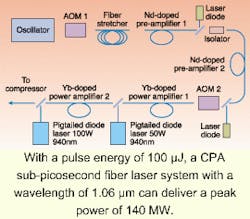Scientists at the Institute for Applied Physics of the Friedrich Schiller University (Jena, Germany) and the Max Born Institute (Berlin, Germany) have demonstrated a powerful sub-picosecond fiberoptic laser system at a wavelength of 1.06 µm. The system, which is based on chirped pulse amplification (CPA) in double-clad fibers and pulse compression, achieved 10-µJ pulses at a repetition rate of 2 MHz using a multimode fiber as the amplifier. Output was 22 W with a reasonable beam quality (m2 approaching 7). With a monomode amplifying fiber, the laser produced 100-µJ pulses at a 32 kHz repetition rate in a nearly diffraction-limited beam (m2 near 1.6).
According to Professor Andreas Tünnermann and colleagues at the Institute for Applied Physics, the modelocked oscillator of the laser system supplies 150-fs, 1.2-nJ pulses at an 82-MHz repetition rate (see figure). An acousto-optic modulator selects every 40th pulse to be fed into a pulse stretcher made of a 2-km standard single-mode fiber. A chain of two neodymium-doped preamplifiers and two ytterbium-doped amplifiers, cladding pumped by fiber-coupled laser diodes, yields the output that is fed to the grating compressor. A second acousto-optic modulator allows the selection of a repetition rate between 32 kHz and 2 MHz to yield the output specified above.
Slope efficiency of the multimode fiber amplifier is 52% (optical to optical). The pulse width is 710 fs, full-width half-maximum. With a pulse energy of 100 µJ, the peak power reaches 140 MW.
The researchers believe the diode-pumped solid-state device, with its unprecedented power and considerably higher frequency than Ti:sapphire CPA systems, has possible applications in micromachining and extreme-ultraviolet generation. Further development of the system may also someday lead to reliable high-power lasers that can be tailored for emission at visible wavelengths such as red, green, and blue for display purposes. For more information, contact Tünnermann at [email protected].
About the Author
Uwe Brinkmann
Contributing Editor, Germany
Uwe Brinkmann was Contributing Editor, Germany, for Laser Focus World.
